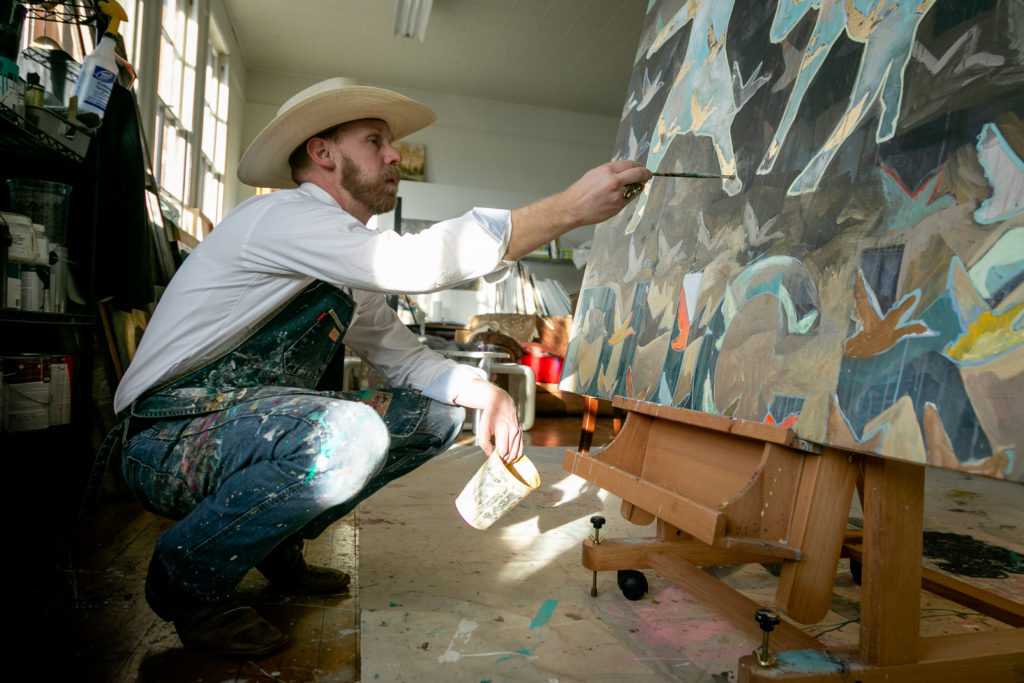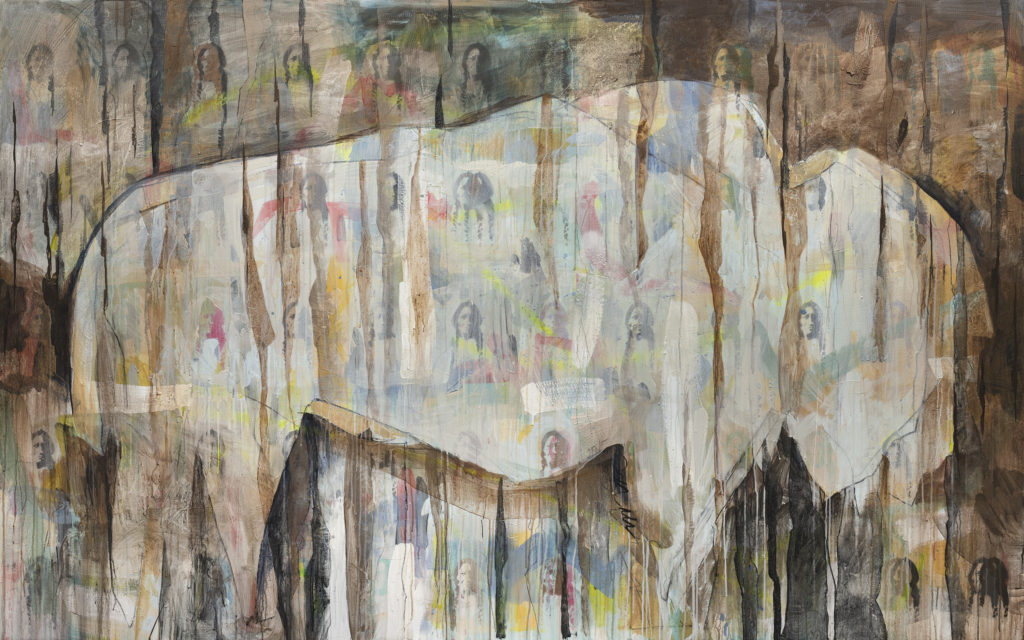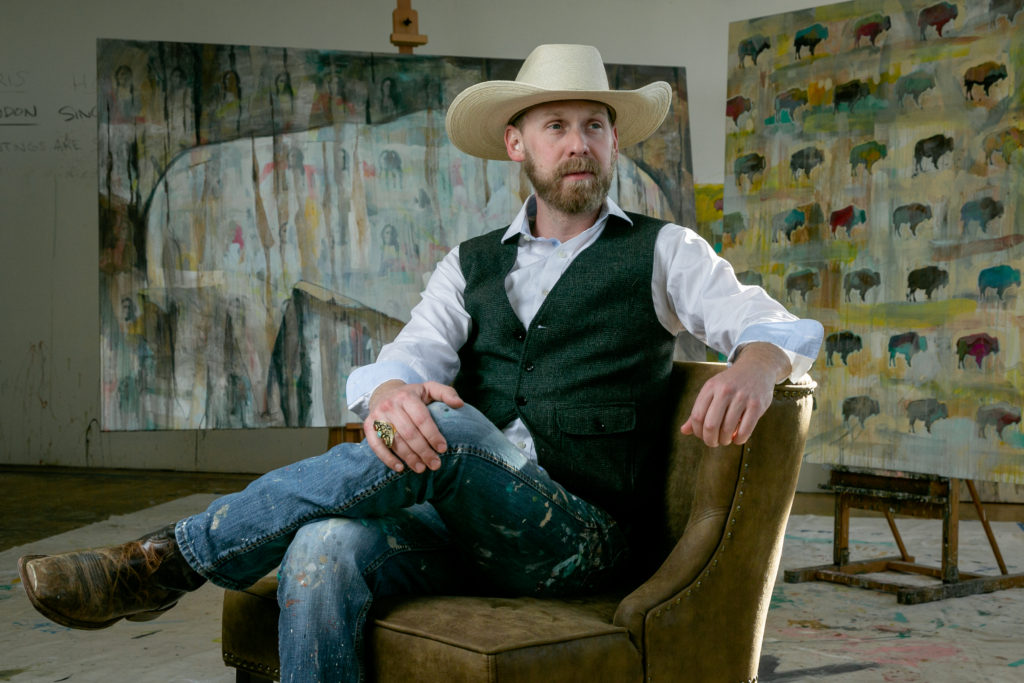A New Take on the Old West

Writer Amanda Christmann
Photography by Bryan Black
[dropcap]M[/dropcap]att Josef may not look like a typical artist. In fact, with his cowboy hat and youthful smile, he looks like he’d be more than comfortable driving a pickup truck to a cattle lot in his native Oklahoma. Yet more days than not, Josef can be found in his Jerome studio surrounded by tubes of acrylic paints, earnestly focused on a canvas as an image summons itself one brush stroke at a time.
A contemporary Western artist, Josef has developed a style that resonates with cowboy and modern art collectors alike. As an autodidactic artist, his images are born more out of instinct than adherence to a particular style.
Many of his images are a nod to abstract expressionism. It’s no surprise that Jackson Pollock and Willem de Kooning are among his favorite artists.
In his backgrounds, Josef sometimes utilizes the drip technique, or action painting, that Pollock made famous. For example, one beautiful painting titled “Room to Run” features five mustangs running across a canvas filled with a speckled background. Taken as a whole, the eye turns the abstruse scene into something that somehow feels organic and natural.
Other paintings more closely reflect de Kooning’s influence, particularly the passages of bright color found in works beyond de Kooning’s black and white period. Several of Josef’s paintings feature pop art-style repetitive images over de Kooning-esque foundations.
“Something amazing pushed me outside of all my comfort zones when I began studying de Kooning’s work,” Josef explained. “I became so intrigued by ‘Woman 1,’ which was considered at the time to be one of the most controversial portraits ever painted of a woman in the history of art.”
The parallel between de Kooning’s execution of “Woman 1” and Josef’s process cannot be ignored. Despite the fact that the strokes that make up “Woman 1” appear haphazard and quick, it took de Kooning over two years to complete. de Kooning agonized over each color and line, scraping and painting over parts he was unhappy with.
Though Josef seldom takes so long, his mindfulness and intention are similar, and it speaks of the profound influence de Kooning has had on his work.
As a boy who grew up in small-town Oklahoma, and whose passion for art had always been fed by his mother, Josef knew he wanted to create. By the time he was 15, Josef had decided that he was going to turn art into a career.
“You kind of start getting to that age where society is having an influence on you,” he said. “I knew I was going to be making art for the rest of my life. I had several conversations with older artists who’d gotten a late start in their art careers. They took a liking to me and they said, ‘Boy, if only I could have gotten started at your age, where I could have been now!’
“Something stuck with me. I realized that, if I was going to achieve my dreams and goals, I would have to make sacrifices.
“At 15, I committed to not having family or wife until I developed my art, and I committed to making it a career by putting in 40 hours a week to do it.”
Despite his drive and desire to create, he hadn’t yet found his own style. de Kooning offered a direction that Josef had not yet realized.
“I came across a book in Barnes and Noble—a biography of de Kooning,” Josef said. “I sunk myself into that book. It became almost religious to me. My eyes lit up.”
Even recalling the memory over a decade later, Josef’s face brightened and his voice became excited.
“Up until that point, I had always been known as the kid who could draw. My family and everybody around me thought I was the world’s greatest artist. I could probably have had an art show at any church in the state, but as an artist, I thought, ‘There’s got to be more in me than ‘pretty’ art.’
“de Kooning was the opposite of ‘pretty.’ He was provocative, and he was doing something I had never seen. It helped push me just a whole ’nother direction. It just grew.”
Josef built an audience and a fame base for his work and continued to look for inspiration. He created his own impromptu shows in warehouses, barns and basements. He painted his way from New Mexico to Seattle and showed his work from Portland to New York City.
While honing his own creative voice, he admired the work of artists he met and looked to mentors for constructive criticism and inspiration. He also studied the raw, edgy work of Frieda Kahlo and the creativity of Georgia O’Keeffe, adding bits and pieces of their influence to his work.
In Taos and Santa Fe, he became friends with several Southwest artists.
“That’s when I got behind the scenes and everything opened wide up,” he said. “I saw the reality of the art world—at least the Southwest art world: the goods, the bads and the uglies.
“I learned, probably more than anything, what I didn’t want my career to be. It was a pivotal moment in life and career. I found myself looking at a lot of successful artists in that region and not liking what I saw.”
He returned to Oklahoma for a family visit, and in a fortuitous turn of events, Josef found himself at a professional turning point at about the same time his opportunities were drying up.
“Normally I always had a pipeline of interest that trickled in. There were no sales and no interest. At first I got frustrated, then I finally just embraced it.
“I went out into the pasture behind my barn studio where we had a couple of old quarter horses. I gave them some loving, and I said, ‘Do you guys mind if I paint you?’
“I’d had people tell me before that I should paint horses, and even though I had done a couple of horses sketches years before, I hadn’t done anything on a horse in years. The next painting I did was ‘Angel in the Pasture.’”
That painting began as an abstract, and it actually came about quite by accident. His young nephew, who was a preschooler at the time, came into Josef’s studio. Before anyone could stop him, he’d grabbed a brush and put a blob of blue paint right in the middle.
“I thought, ‘What am I going to do with it now?’ When I came back in to paint the horses a few days later, I looked at that painting and knew a horse was supposed to be right there where my nephew left his mark. That space was perfect. It’s probably my favorite painting I’ve ever done.”
It was the evolution of a new style for Josef, and not only has it grown his audience, but it feels right to the artist.
“I saw so much opportunity and freedom within the realm of becoming more abstract, more expressionist—becoming more loose. My art is constantly a work in progress,” he said, “but I’ve found more of my voice in my style than ever before.”
After opening dozens of studios and creating his own artistic brand, Josef had decided to take a break from gallery exhibits and focus on travel and events. From his Jerome studio, he’s had time to experiment with colors and ideas.
“I took a break and really held off on pursuing galleries,” he said. “I’ve been really taking my time to try my best to find the right fit. I have good opportunities on a regular basis and I turn them down.
“The wall space is out there. That’s easy. I want more than that, though. I want a relationship, and I want someone to see something in me.”
He found that fit in Carefree’s Grace Renee Gallery.
“I love the energy they’ve created in their showroom,” he said. “I want to work with a great gallery, whether that gallery has been around for a long time or it’s a new gallery. I see a lot of potential with what the owner, Shelly Spence, is doing and I really dig what she’s about.”
As for the future, Josef envisions creating a legacy—both through art, and with art as a tool for something bigger.
“Maybe I create enough that, financially, I’m helping generations to come. I think that’s the ultimate career goal with it. My personal goal is to make sure that I enjoy the journey.”
With a smile the size of Oklahoma he added, “All we really have is right now. It’s great to have big dreams and big ideas, but at the end of the day, if you don’t love who’s around you, it’s not worth it.”
Experience
Artist Reception with Matt Josef
Thursday, April 25 | 4–7 p.m. | Grace Renee Gallery | 7212 E. Ho Hum Rd., Carefree | Free | 480-575-8080 | gracereneegallery.com




